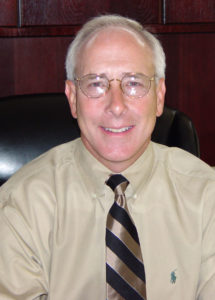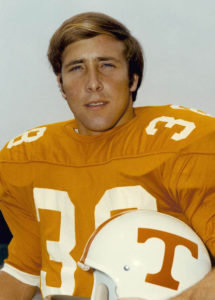Around 1,000 babies are born each year in the United States with sickle cell anemia. An inherited condition, it causes regularly round red blood cells to take on a sickle shape and die early, leaving a shortage of healthy red blood cells, blocking blood flow, and causing fatigue and pain, strokes, and a shortened life span. And one UT alumnus may be close to finding a treatment that can avert the disorder in infants before it begins.
As a professor and researcher of microbiology and molecular genetics at the University of Alabama at Birmingham, Tim Townes (’73, ’76, ’80) has studied sickle cell anemia and the genes associated with it for three decades. Now, Townes and his colleagues have developed a cure for infants. “It involves identifying infants who are going to get sickle cell anemia,” says Townes, “isolating their stem cells from umbilical cord blood, correcting the sickle gene, and giving them back to the patient. The methodology is under review with the Food and Drug Administration. They’re very careful, and rightly so, but we are hopeful that our treatment will be approved.”
The 5’9” Strong Safety That Could
UT football fans love the story of Townes, who grew up in Knoxville selling programs on game day. He walked on at UT as a 5’9”, 160-pound strong safety out of Bearden High and earned a starting spot and a scholarship as a result of his relentless work ethic and his reputation as one of the hardest hitters on the team. “Tim was absolutely one of the most dedicated football players that I have ever seen and one of the greatest human beings that I have ever known,” said UT Athletics Director Phillip Fulmer, Townes’s teammate in 1971. “He always had a smile on his face and was always personable. When he went to practice, he went with the intent of doing his best in every drill and every play.”
Townes graduated with his biology degree in 1973. He wanted to be an orthopedic surgeon, but he didn’t do well on the MCATs. “I can remember how disappointed I was that I didn’t get into medical school. That’s all I had ever wanted to do—to be a surgeon. But then I decided to get my master’s degree, and I got into a lab at UT hospital and fell in love with science and research. That’s what I thought I loved about medicine, but I realized it was the science behind it that I loved. I finished my degree and published two papers.” For his PhD, he switched to microbiology, which Townes loved because it involved all the cells in the body and the regulatory mechanisms that activate them.
The New Frontiers of Microbiology
 “It was right when people started cloning genes,” Townes remembered on a Host of Volunteers podcast. “You could chop DNA up, then clone it in bacterial plasmids, and then do DNA sequencing. It was the era when all that started. And I just happened to be in a lab where part of that started, too. We learned how to do molecular biology. I was always interested in how genes functioned.
“It was right when people started cloning genes,” Townes remembered on a Host of Volunteers podcast. “You could chop DNA up, then clone it in bacterial plasmids, and then do DNA sequencing. It was the era when all that started. And I just happened to be in a lab where part of that started, too. We learned how to do molecular biology. I was always interested in how genes functioned.
“Every cell in your body has the same number and kind of genes, because you came from one cell, a fertilized egg. And now you have brain cells and blood cells and they have exactly the same genes. They’re not different because they have different genes, they’re different because they all have different subsets of those genes that are active or silent, and that means that there has to be some regulatory method, some biochemical mechanism that turns genes on and turns them off.”
Townes has received many National Institute of Health grants and has been published in prestigious publications like Science and Nature. He completed his postdoctoral training in biochemistry and molecular genetics at the University of Cincinnati School of Medicine and then joined the faculty of the UAB School of Medicine’s Department of Biochemistry and Molecular Genetics in 1984.
“How’s About . . . ”
When Townes moved to Birmingham, he started going to Briarwood Presbyterian Church, which had been founded by a Navy fighter pilot turned seminarian named Frank Barker. At Saturday morning men’s prayer breakfasts in the Barkers’ home, Barker’s wife, Barbara, cooked for the group. Often their daughter Peggy helped. Tim and Peggy started dating in 1986 and were married in 1987. They have six children and eight grandchildren. Today Peggy directs Briarwood’s ballet program, which has some 15 instructors and 500 students and has performed in far-flung venues like Lima, Peru; Havana, Cuba; and St. Petersburg, Russia.
‘There’s No Reason We Can’t Be the People.’
 Townes chaired his department at UAB from 2001 to 2016 before becoming a professor emeritus a couple of years ago. He also founded the UAB Stem Cell Institute in 2010. He has published over 90 peer-reviewed papers, has several issued patents, and still speaks regularly at international conferences on gene regulation and gene therapy.
Townes chaired his department at UAB from 2001 to 2016 before becoming a professor emeritus a couple of years ago. He also founded the UAB Stem Cell Institute in 2010. He has published over 90 peer-reviewed papers, has several issued patents, and still speaks regularly at international conferences on gene regulation and gene therapy.
The major research interest of Townes’s laboratory has been in developing genetic therapies for blood disorders such as sickle cell disease and severe combined immunodeficiency. On the Host of Volunteers podcast, Townes compared the years of research to what he learned as a UT player: “It’s just like football practice. It’s busting your tail.” He has given his graduate students and other colleagues a pep talk: “They’re no smarter than you at Harvard or Stanford. There’s no reason in the world we can’t be the people who cure sickle cell disease with our modified CRISPR/Cas system for editing genes.”
Editing of genes is the key to Townes’s treatment for sickle cell anemia. First, his team identifies newborns with the sickle cell trait. Since it is an inherited disease, it is easy to identify the children who will get sickle cell anemia. “At birth,” Townes said, “umbilical cord blood is collected, stem cells are purified, and the sickle gene is corrected. After gene correction, the cells can be easily transfused back into the patient at 3 to 6 months of age. The corrected red blood cells live much longer than the sickle cells and will quickly replace enough cells to cure the disease before tissue and organ damage occur. The corrected stem cells will actively produce normal red blood cells for the rest of the patient’s life.”
“We have a technology that is more efficient, safer, and more cost effective than other approaches,” Townes said, “and we are applying to the Food and Drug Administration to transplant cells corrected by this method back into kids. When you are editing a particular gene, like a sickle cell gene, it’s like you’re finding and replacing one letter out of three billion in a word document. There are a lot of other disorders that are like that, severe combined immune deficiencies and thalassemias. Some day we will be able to use similar technology to engineer white blood cells to attack cancer cells that cause leukemias and solid tumors.”


2 comments
Amazing !! Kudos !!
Agree with you!